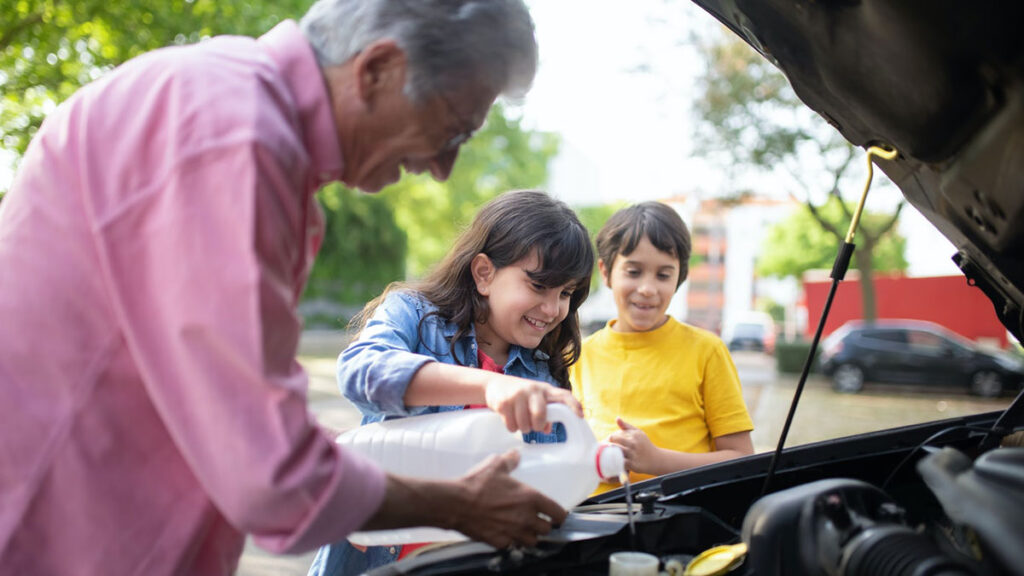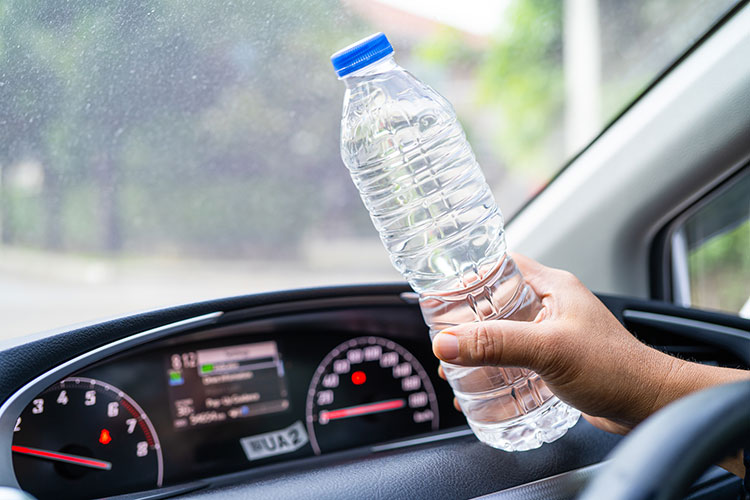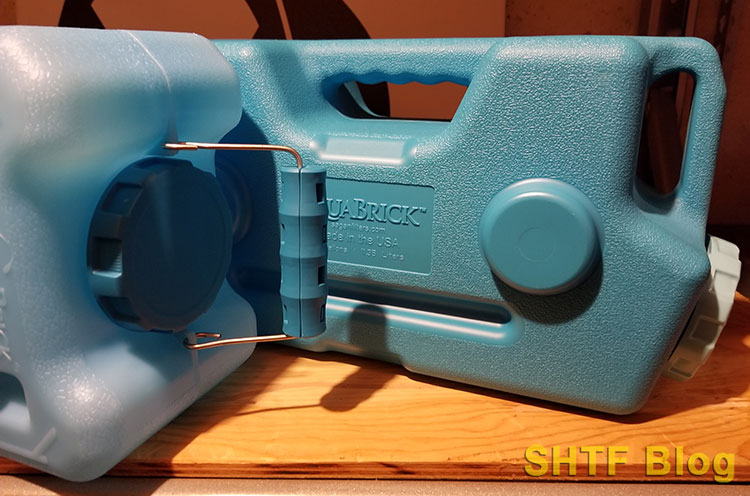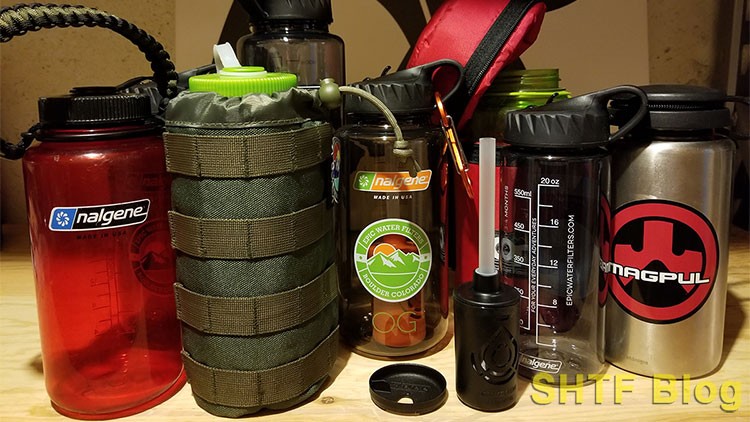
Have you ever found yourself stranded on the side of the road? Maybe you left on a long trip only to realize you didn’t pack enough water? Occasions like these are why it is essential that you know how to store water in your vehicle.
Smart preppers keep emergency water stored in their vehicles at all times. You never know when an emergency might occur. Your car could break down or you get stuck in the snow far from help. It’s even possible that you might need to conduct a rapid bug out. Having water prepositioned in your vehicle will help increase the odds of both your comfort and your survival.
The obvious question for people that live in seasonal climates (like me) is how do you keep water stored in your vehicle through every season? Will it not get too hot in the summer and freeze in the winter?
Yes, of course. However, there are ways to mitigate these issues. After all, warm water is better than no water, and ice melts.
What follows are ways you can safely store water in your vehicle through all seasons. We will discuss various storage containers, what to avoid, and cover a few creative ideas.
Avoid Single-Use Plastic Bottles
Recycled, single-use plastic bottles – convenient, easy, and inexpensive. But are they the best for storing emergency water in your vehicle? No. Unnecessary waste and negative health aspects are the reasons.

Single-use plastics create a lot of waste (most of which ends up in the ocean), especially when considering how many twenty-four packs you are going to be restocking your car with throughout the year.
There are better, safer, more environmentally friendly options that are honestly more effective. Besides unnecessary waste, plastic bottles have a slew of other downsides that make them unworthy, including:
- Single-use plastic can freeze and crack in winter.
- Pressure can build up, causing the bottle to burst – especially if you live in an area where your commute can result in significant elevation changes.
- Plastic can leach chemicals into your drinking water.
- Your water may have a chemical or plastic taste – particularly if the bottles have sat in a warm car for several days.
- Plastic degrades over time – UV exposure speeds up this process.
Of course, in an emergency, the potential risks of single-use plastics are not going to outweigh the dangers of not drinking water at all. If this is all you have access to, you should drink it. However, survivalists like to plan ahead and be prepared for any situation. If you can plan ahead there are better quality containers to consider.
5 Best Containers to Store Water in Your Vehicle
There are a plenty of good storage containers that will work to store water in your vehicle. What works best may depend on the size and amount of storage space in your vehicle. You may also find that one style is better suited for warmer temperatures, while another is best for cold temperatures. Let’s start by looking at one of the most basic options.
1 – Boxed or Canned Water
Boxed or canned water containers are still single-use (recyclable) products. However, unlike plastics, the pros outweigh the cons. Though they may only be marginally more beneficial for the environment, they are safer for you.
Boxed water is an excellent option for hot and cold climates – just keep in mind that the box could potentially tear in freezing temperatures. The best way to store this water in your vehicle is inside a cooler. If shoved under your back seat or in your trunk, they could easily get crushed. Inside a cooler, though, the boxes will be secure and better insulated from changing temperatures, and if they did break, they’d be contained inside the cooler.
- 100% PURE, REFRESHING WATER - With Boxed Water Is Better, you can enjoy no added minerals - a sustainable option for kids lunches and events.
- PLANT-BASED CARTON - Better than bottled or canned water, our case of water contains renewable, reusuable cartons that are made from 92% renewable materials, mostly paper sourced from well managed...
- CLEAN, CRISP TASTE - Our water purification process, inclduing reverse osmosis & carbon filtration, gives our award-winning drinking water a clean taste without additives or other ingredients; it's...
- SUSTAINABLE SOLUTION - Boxed water cartons illustrate the simple way we can all improve the planet and quality of life; not only is the 24 pack of water recyclable, but it's also refillable, making it...
Canned water is not ideal for winter – cans will freeze and burst in cold temperatures. Outside of winter, however, cans are excellent and economical. Aluminum does not degrade nearly as quickly as plastic, so they are long-lasting and safe. Some brands, such as Blue Can, boast a 50-year shelf life!
The best aspect of both boxed and canned water is that they do not leach BPA or other harmful chemicals into your drinking water.
2 – Purified Water Pouches
Water pouches are a great Plan B. They do not take up a lot of space, so you can have them in addition to other preferred water storing methods. Each pouch typically holds around 4 ounces of water. You can stuff them in the glove box or console for quick access. These pouches are also great to store in the spare tire compartment.
- Emergency purified water for immediate use; lightweight and extremely compact(64)-125 ml sachets
- Loss potential minimized due to individual sachets and ideal for storage.Pallet volume:60 ft3 (1.70 m3)
- Easy to dispense from a pre-measured sachet; superior packaging materials for optimum durability in your survival kit
- Such, Canadian Coast guard, EC and NZ approval (nan 8960 0112 4454 3)
They are easy, convenient, and relatively inexpensive. If one were to leak, it isn’t going to flood your vehicle. It is possible that they will freeze in winter, but they would also be easy to thaw. The main downsides are that your water may have a plastic taste and the pouches are not recyclable.
3 – Quality Plastic Water Containers
Different from single-use plastic bottles, these containers are safer to use and built to last. They also come in a wide variety of shapes and sizes, from 7-gallon jugs (you probably wouldn’t want anything heavier than that) to 32-ounce Nalgene bottles. Here are some of my favorite containers:
- AquaBrick – A wrote a WaterBrick vs AquaBrick comparison article a while ago. The AquaBrick from SaganLife is definitely my favorite. It’s durable and has optional add-ons like water filters. They can also be used for storing food.

- Water Bladders – Bladders such as the MSR Dromedary are perfect when space is an issue. It is made of a collapsible, but extremely durable material. You can stack as many as you need in your trunk or cargo space. I cannot speak to it, as I have never had mine freeze, but MSR does claim that the bladder can withstand freezing. The Dromedary also features a BPA-free, food-grade lining.
- Scepter 5 Gallon Can – If you have the space, a couple of 5-gallon jugs in your vehicle is a great way to store emergency water. These can be strapped into the back of your SUV or the bed of a truck. I certainly recommend strapping them down, as I have had them fall over and leak. The Scepter (or similar styles) can be used in all seasons. Remember to fill them only ¾ of the way full in winter to prevent damage – water expands as it freezes.
- Meticulously crafted from food-grade polyethylene plastic that does not add taste, odor, or chemicals to the water; Clean water contained in this 5 gallon jug will stay clean
- Camping water jug is durable against puncture damage which is ideal for outdoor trips; Will provide potable water in a number of environments and situations as it is based on military specifications
- 5 gallon water container features a carry handle which makes the transfer from vehicles to campsites and vice-versa easy and convenient for easy moving around and for easier lifting, carrying, pouring
- Includes a flexible reversible spout that ensures no spilling or leaks will happen; Also has a cap that resists leaks securing your potable water won't be wasted in storage
These are all made from BPA-free plastics; however, your water will have a plastic taste if you leave it in the container too long. Replacing your water every few weeks will remedy this. You also want to give the containers a good soak and scrub every few months, or whenever you change out your water (do not wait longer than six months). Bacteria can build up that will make you sick.
4 – Stainless Steel Water Containers
Stainless steel may be the GOAT (greatest of all time) emergency water storage container. It is certainly the most durable. These bottles can roll around under your seat or in your trunk and you never have to worry about cracks or breaks.
Food-grade stainless steel is also one of the safest materials. It will not leach chemicals into your water. They are often insulated as well and come with vacuum seal lids that prevent leaks.

Stainless Steel bottles come in a variety of brands and size options. Keep one or two in the back of the vehicle and you should be all set. If those are a little big for your taste, my favorite by far is the Nalgene Stainless Steel Bottle. This is because the Nalgene bottle is the gold standard of water bottles and there are many Nalgene accessories that you can use to make the bottle more versatile.
Bottles that are insulated often work well in all seasons, and if you click on the Nalgene accessories link above, you’ll find insulated Nalgene covers there. If you fill your containers no more than ¾ of the way full you do not have to worry about damage from freezing. Additionally, these bottles tend to keep water at a more pleasant temperature in hot climates.
I take two of these with me everywhere I go. They are easy to carry, come in a variety of lovely colors (if that matters to you at all), and keep my water fresh and cool.
5 – Glass Containers
Some people prefer using glass containers because they are clean. By clean, I mean glass does not leach chemicals or absorb gross smells. We have all taken a sip out of a funky Nalgene and know it isn’t pleasant (stainless is also better for taste/smell). With glass, this is avoidable (as long as you keep the container clean, of course).
That said, glass is not the perfect container for everyone. Though they are constructed of heavy duty-material, any glass can break. When it does, you not only have spilled water but also broken glass to clean up. If you are someone who frequently drives off-road – on rough gravel or rocky terrain – glass probably isn’t ideal.
If you do choose glass containers for water storage, make sure to wrap them in a blanket. Military-style wool blankets are great for this. They lessen impacts, provide some insulation, and the blankets can also be used for yourself in an emergency. Keep in mind that your glass could also crack if the container is left fully filled in the winter.
Again, storing these containers inside a cooler that can contain other survival gear will help contain any broken glass if that were to happen.
Consider Water Filters and Purification
In addition to your emergency water storage containers, it is always a good idea to have a dependable filter or purification system. If you run out of water and need to refill from a nearby water source (hopefully a cool mountain stream), you should filter it first.
The easiest system I’ve found is LifeStraw. Lifestraw is just as it sounds, it’s a straw filter. You place it in your water bottle, and it filters as you drink. These are lightweight, compact, effective, and extremely simple to use. Their small size makes them particularly use for vehicles. You easily throw one in your glovebox.
- Protects against 99.999999% of bacteria (including E.coli, Salmonella; 99.999% of parasites (including Giardia and Cryptosporidium); 99.999% of microplastics, silt, sand, and cloudiness
- Ultralight and durable, the LifeStraw weighs less than 2 ounces (46 g) so you can pack it anywhere
- Long-lasting membrane microfilter will last up to 1,000 gallons (4,000 L) of water, that’s enough drinking water for an individual for over 5 years
- Be prepared with the ultimate survival tool, the LifeStraw has an unlimited shelf life and has been tested all over the globe to face the harshest conditions
Another simple solution can be found in water purification tablets. These germicide tablets kill Giardia lamblia – the bacteria in water sources that most often makes us sick. Tablets have a track record of having an undesirable taste and color. However, Potable Aqua comes with purification tablets as well as neutralizing tablets to help reduce the iodine taste.
- One bottle of 50 Potable Aqua Water Purification Tablets and one bottle of 50 Potable Aqua PA Plus tables
- Water purification tablets make questionable water bacteriologically suitable to drink in emergency water situations
- These water purification tablets for drinking water leaves no iodine taste or color in your emergency water, when used correctly.
- Portable water treatment tablets are effective against bacteria and Giardia lamblia, for trusted emergency water purification
Again, these are great for vehicles because they are so easily stored.
Tips for Storing Water in Your Vehicle in Cold Weather
Storing emergency water in your vehicle during winter can be tricky, but it is not impossible. There are simple solutions that can prevent at least some of your water from freezing.
- Keep your water wrapped in a military-style wool blanket in the car to slow down the freezing process. The interior of your vehicle will stay warmer than your trunk or covered truck bed. Plus, if you have previously been driving with the heat on, the water is likely to have thawed anyway.
- Get in the habit of taking a couple fresh water bottles with you everywhere you go. As mentioned previously, I pack two stainless steel Nalgene bottles every time I get in a vehicle.
- Replace, or at least check on, your stored water frequently in winter. If you find it frozen, exchange those containers for fresh ones.
- Use insulated bottles, the water is less likely to freeze solid.
Though at some point even the best water container is likely to freeze, they can also be thawed. Hand warmers, such as hot hands, are an extremely efficient and easy way to thaw out smaller water containers (i.e., Nalgenes, water pouches, or water cans). Simply activate the hot hands and wrap them up in a blanket with the bottle.
Tips for Storing Water in Your Vehicle in Hot Weather
Storing water in hot weather is less of a hassle than in cold weather in many ways. Still yet, even when it is a pleasant 70 degrees outside, inside your car can reach temperatures above 100 degrees. At worst, your water is probably going to be warm and, thus, not as satisfying.
Warm water still hydrates you, however, and that the most important thing. The outside versus inside temperature difference is not insignificant, though. Here are some things to keep in mind for hot weather water storage:
- Stay away from single-use plastic containers – this will prevent you from dealing with chemical leaching or water that tastes like plastic. Even the BPA-free containers may leach other potentially harmful chemicals in hot temperatures.
- Try to keep your water in the shade – under the seat or in an insulated cooler is best. To deflect heat, I have seen people wrap their coolers in the reflective window shades meant for vehicles or RVs.
- Use insulated water bottles – you can refresh these regularly with ice and keep them in a cooler.
- Refresh your water regularly – you don’t want your water supply getting funky or your containers growing bacteria. You should replace water at least every six months, beyond this point water can become unsafe to drink. Personally, I prefer to replace it more frequently in the summer, every 4-6 weeks.
Conclusion
Water is life. There is no question about it. Our bodies need water to survive, which is why it is essential to store emergency water in your vehicle. You never know when you could find yourself in a situation where you need it. It is always best to be prepared.
I encourage you to try out the containers listed above and see what works best for you in different seasons. There is an option out there for everyone. Remember to keep your water filter or purification system on hand and always keep track of your stores. Know how much you have and how long it has been in the container. Keep it fresh!







4 comments
Interesting selection for storing water. Not my selection, but interesting. Especially the comment about single use plastic containers. The water in my vehicle falls into two categories, emergency or forgotten. For emergency I keep a minimum of a 1 gallon container; a single use sealed bottle. This is exactly for emergencies only so I’m not throwing away multiple containers. I keep this for drinking, but mostly for vehicle emergencies like a blown radiator hose or such. Then I keep a few smaller bottles for drinking water. While they start as single use bottles, they are usually of a thicker plastic that I then refill because these are being rotated or used frequently. Admittedly, I don’t have to worry about freezing issues.
Definitely more than one way to get it done. The most important thing is finding SOME way to get it done. Thanks for the comment.
You can also leave your water bottles in an insulated cooler to help mitigate freezing if you can’t bring the containers in every night. You can get coolers with handles – also works well to keep MREs from freezing too.
To be able to do this year round, we use the 4 oz. water packs. We keep them in a clear, plastic tub, and tape it close. In the Winter, you can put one under your leg while sitting, and warm it enough to drink. Ask me how I know!